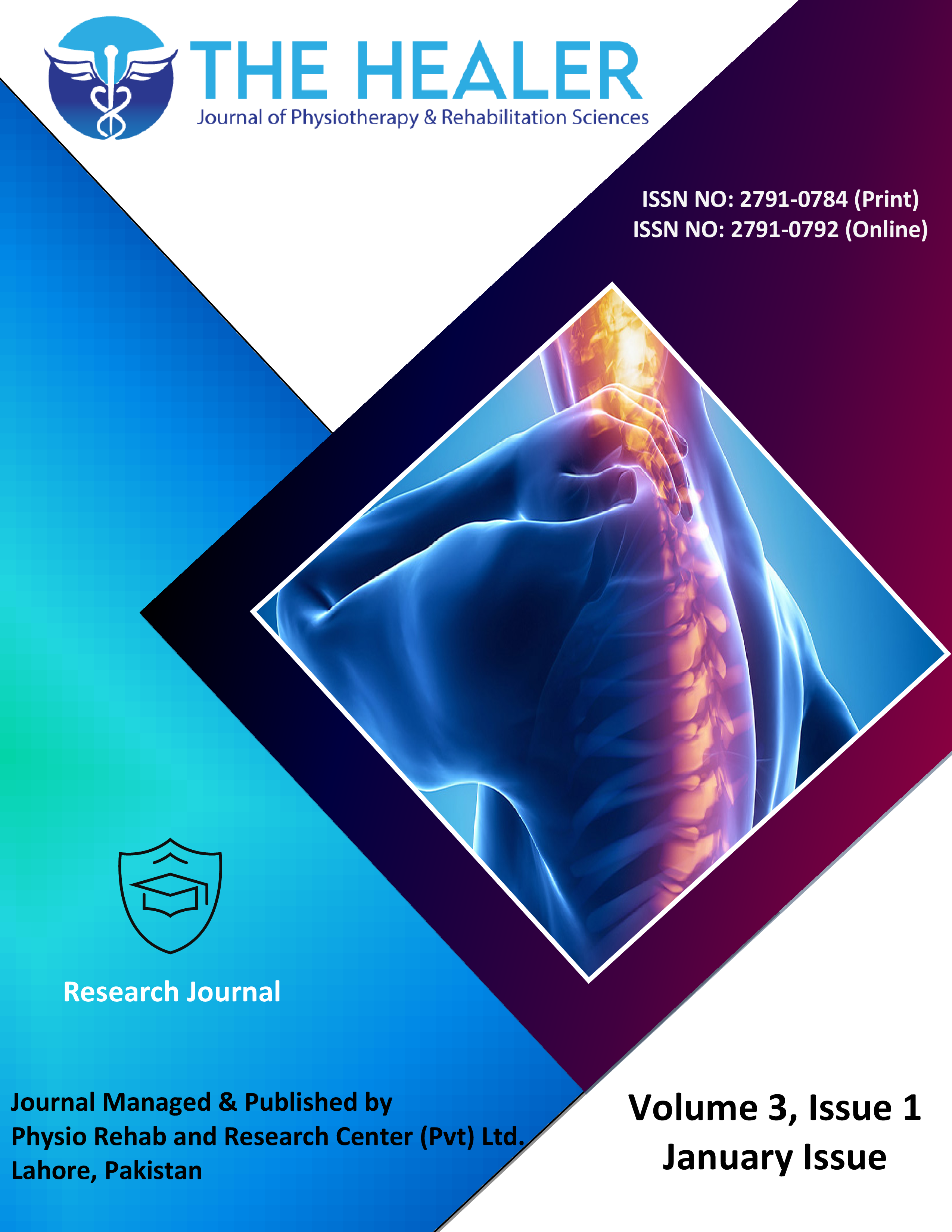Effectiveness of Virtual Rehabilitation Versus Therapeutic Exercises in the Balance Training of Lower Limb Among Post-Stroke Patients
Virtual Rehabilitation in Patients with Stroke
DOI:
https://doi.org/10.55735/hjprs.v3i1.119Keywords:
balance, physical therapy, stroke, virtual realityAbstract
Background: Stroke is the major source of death and disability and leads to impaired balance in post-stroke patients. Balance training is one of the main components of stroke rehabilitation. Virtual rehabilitation is gaining more popularity as it engages the patients attention in training. Objective: To evaluate the effects of virtual rehabilitation versus therapeutic exercises to improve the balance in patients with stroke. Methods: This randomized controlled trial conducted at Abdullah Hospital, Lalamusa from August to December 2022. The sample size of 30 participants was randomly divided into two groups virtual therapy group versus therapeutic exercises group, after taking their informed consent. Participants were recruited through the non-probability purposive sampling, between the age of 35 to 55 years, post-stroke survivors after 3 months and were able to stand up with or without assistive devices. Participants with auditory or visual dysfunction, a history of deep venous thrombosis, lower limb amputation, severe receptive or expressive aphasia, significant cognitive impairments and unstable hypertension were excluded. The data was collected from the patients by using Berg Balance Scale (BSS) at three different time frames: baseline, mid-intervention and post-intervention. The Shapiro-Wilk test was applied to calculate the normality of the data. For descriptive analysis, quantitative variables were calculated by mean and standard deviation whereas, for qualitative variables, frequency and percentages were used. To find significance an independent sample t-test was applied for between-group analysis and two-way repeated measure ANOVA was used to measure within-group analysis. Results: Both groups improved their balance after six months of intervention. Comparative analysis showed a significant improvement with p-value≤0.05 in both groups. The mean and standard deviation after six weeks of intervention in the virtual training group was 55.4±0.82 and the therapeutic exercise group was 54.47±1.3. This showed that the virtual rehabilitation group had improved balance in patients with stroke. Conclusion: Virtual rehabilitation was found to be effective in improving the balance of patients with stroke. It not only improves balance but also engages the patient in the treatment protocol. This rehabilitation is effective for the balance training of post-stroke patients.
References
Feigin VL, Stark BA, Johnson CO, et al. Global, regional, and national burden of stroke and its risk factors, 1990–2019: A systematic analysis for the Global Burden of Disease Study 2019. The Lancet Neurology 2021; 20(10): 795-820.
Gibbons EM, Thomson AN, de Noronha M, Joseph S. Are virtual reality technologies effective in improving lower limb outcomes for patients following stroke–a systematic review with meta-analysis. Topics in stroke rehabilitation 2016; 23(6): 440-57.
De Luca R, Manuli A, De Domenico C, et al. Improving neuropsychiatric symptoms following stroke using virtual reality: A case report. Medicine 2019; 98(19).
Johnson CO, Nguyen M, Roth GA, et al. Global, regional, and national burden of stroke, 1990–2016: a systematic analysis for the Global Burden of Disease Study 2016. The Lancet Neurology 2019; 18(5): 439-58.
Patlolla SH, Lee H-C, Noseworthy PA, et al. Impact of diabetes mellitus on stroke and survival in patients with atrial fibrillation. The American journal of cardiology 2020; 131: 33-9.
Oladiran O, Nwosu I. Stroke risk stratification in atrial fibrillation: a review of common risk factors. Journal of community hospital internal medicine perspectives 2019; 9(2): 113-20.
Alharbi AS, Alhayan MS, Alnami SK, et al. Epidemiology and Risk Factors of Stroke. Archives of Pharmacy Practice 2019; 10(4).
Li J, Zhong D, Ye J, et al. Rehabilitation for balance impairment in patients after stroke: a protocol of a systematic review and network meta-analysis. BMJ open 2019; 9(7): e026844.
Schinkel-Ivy A, Huntley AH, Danells CJ, Inness EL, Mansfield A. Improvements in balance reaction impairments following reactive balance training in individuals with sub-acute stroke: a prospective cohort study with historical control. Topics in stroke rehabilitation 2020; 27(4): 262-71.
Gunning E, Uszynski MK. Effectiveness of the proprioceptive neuromuscular facilitation method on gait parameters in patients with stroke: a systematic review. Archives of Physical Medicine and Rehabilitation 2019; 100(5): 980-6.
Díaz-Arribas MJ, Martín-Casas P, Cano-de-la-Cuerda R, Plaza-Manzano G. Effectiveness of the Bobath concept in the treatment of stroke: a systematic review. Disability and Rehabilitation 2020; 42(12): 1636-49.
Saleh MSM, Rehab NI, Aly SMA. Effect of aquatic versus land motor dual task training on balance and gait of patients with chronic stroke: A randomized controlled trial. NeuroRehabilitation 2019; 44(4): 485-92.
van Wissen K, Blanchard D. Circuit class therapy for improving mobility after stroke: A Cochrane review summary. International journal of nursing studies 2019; 97: 130-1.
Hung Y-X, Huang P-C, Chen K-T, Chu W-C. What do stroke patients look for in game-based rehabilitation: a survey study. Medicine 2016; 95(11).
In T, Lee K, Song C. Virtual reality reflection therapy improves balance and gait in patients with chronic stroke: randomized controlled trials. Medical science monitor: international medical journal of experimental and clinical research 2016; 22: 4046.
Lee H-C, Huang C-L, Ho S-H, Sung W-H. The effect of a virtual reality game intervention on balance for patients with stroke: a randomized controlled trial. Games for health journal 2017; 6(5): 303-11.
Lohse KR, Boyd LA, Hodges NJ. Engaging environments enhance motor skill learning in a computer gaming task. Journal of motor behavior 2016; 48(2): 172-82.
Liao W-w, McCombe Waller S, Whitall J. Kinect-based individualized upper extremity rehabilitation is effective and feasible for individuals with stroke using a transition from clinic to home protocol. Cogent Medicine 2018; 5(1): 1428038.
Pasco D. The potential of using virtual reality technology in physical activity settings. Quest 2013; 65(4): 429-41.
Lima C, Ricci N, Nogueira E, Perracini MR. The Berg Balance Scale as a clinical screening tool to predict fall risk in older adults: a systematic review. Physiotherapy 2018; 104(4): 383-94.
Rohrbach N, Chicklis E, Levac DE. What is the impact of user affect on motor learning in virtual environments after stroke? A scoping review. Journal of neuroengineering and rehabilitation 2019; 16(1): 1-14.
Park D-S, Lee D-G, Lee K, Lee G. Effects of virtual reality training using Xbox Kinect on motor function in stroke survivors: a preliminary study. Journal of Stroke and Cerebrovascular Diseases 2017; 26(10): 2313-9.
Shobhana NG, Rakholiya S. The effect of X box 360 kinect-virtual reality intervention on balance and gait training in stroke patient: An interventional study. Indian J Public Health Res Dev 2020; 11: 589-94.
Arshad H, Khattak HG, Anwar K, Majeed Y, Malakandi HB. Comparison of exergames versus traditional balance exercise to improve balance and reduce risk of falls in chronic stroke patients. Journal of Medical Sciences 2022; 30(02): 134-8.

Downloads
Published
How to Cite
License
Copyright (c) 2023 The Healer Journal of Physiotherapy and Rehabilitation Sciences

This work is licensed under a Creative Commons Attribution 4.0 International License.
CC BY












